Street foods are part of almost any country’s culture, and the Philippines, particularly the capital of Manila, has no shortage of these cheap and yummy delicacies. Most of street foods found in Manila are deep-fried, from fruits to entrails, but in these list, we also cover some stews, soups and other street food items.
Here are some of the most common street foods in Manila that you and your AFAM friends should try – if you haven’t yet.
GRILLED MEATS
1. Isaw
A popular dish found from carts to bars, this offal dish consists of marinated pork or chicken intestines skewered on a stick, then grilled to perfection. The intestines are meticulously cleaned, then marinated in ketchup, soy sauce, garlic, and other seasonings prior to grilling.
Cost: P5 to P6
2. Betamax
named after the now-defunct videocasette tape, this grilled dish is made from coagulated chicken blood mixed with water, salt, and pepper. The blood is slicked into thin squares and skewered in 3 or 4 pieces on a stick, then basted with a mixture of oil, soy sauce, and ketchup.
Cost: P5 per stick
3. Helmet
Feeling a little adventurous? Try helmet. This is basically three chicken heads marinated in the same marinade as isaw, then grilled and basted with an oil-ketchup-soy sauce mixture.
Cost: P10 to P15 per stick
4. Adidas
A testament to the Filipino cuisine making use of every possible meat part, adidas is basically a chicken foot on a stick. The marinade is the same with isaw.
Cost: P5 to P7
5. Inihaw na tenga
Popular both as a snack and beer match, this consists of pig ears cut into squares, boiled in soy a sauce-vinegar mix, then grilled to a crisp.
Cost: P6 to P10
6. Barbecue
Simple called barbecue, this grilled favorite uses tender pig meat (lomo, usually) that is marinated in ketchup, brown sugar, soy sauce, black pepper, garlic, and onion. The meat is skewered, then grilled.
Cost: P12 to P15 per stick
FRIED MEAT AND EGGS
7. Tokneneng and quek-quek
These fried eggs are ubiquitous across Manila, and are a filling source of protein for many. The tokneneng is made with chicken egg, while quek-quek with quail egg. Both covered in a tasty orange-colored batter, then deep fried after, both pair well with a onion and vinegar dip.
Cost: P2 pesos per piece for quek-quek; P10 to P15 for tokneneng
8. Balut at penoy
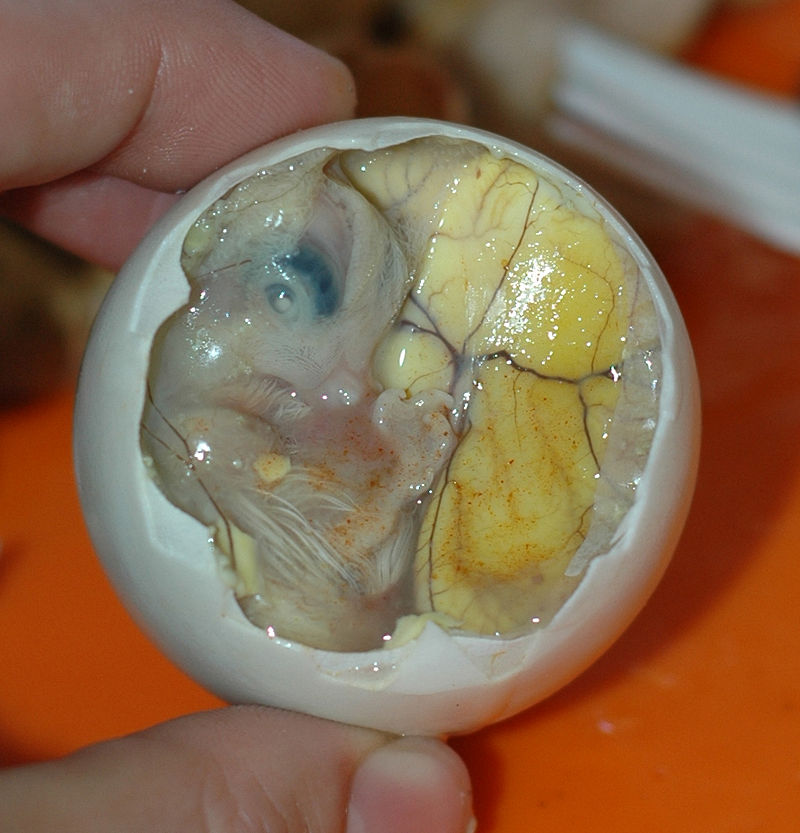
Balut is one of the most well-known Philippine street foods around the world, mainly because foreigners find it odd and befitting of a Fear Factor challenge. Balut is basically a fertilized duck embryo – which you can see once you peel the shell – that is incubated anywhere between 14 to 21 days, then boiled and sold with the shell still intact.
If you find balut icky for your taste, opt for a penoy. Unlike balut, penoy is boiled with the duck egg still unfertilized, and almost seems like your typical hardboiled eg..
Cost: P12 to P15
9. Kikiam
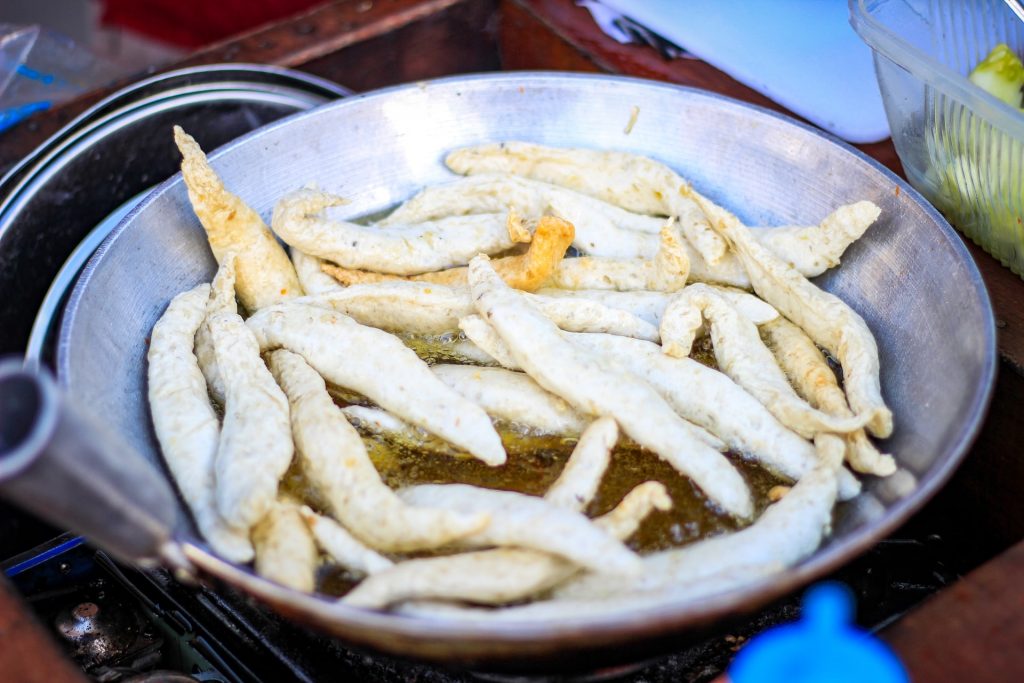
Although originating from the Chinese kikiam, the kikiam sold on the streets in Manila actually consists of fish meat (not pork) and fillers. These finger-size delicacies are deep-fried and served with sweet, spicy, or vinegar dip – your choice.
Cost: P1 to P2 each
10. Fishball, chicken ball, and squidball
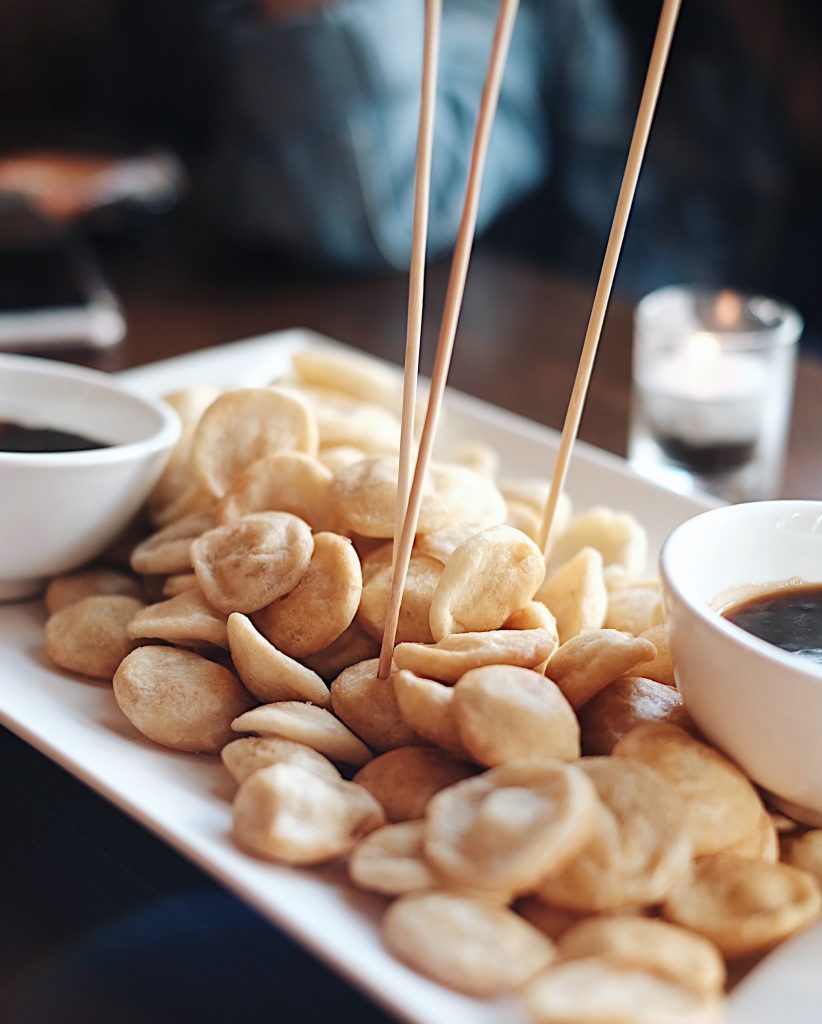
Like the kikiam, these fried tiny “balls” contain tiny amounts of fish, chicken, and squid meat and fillers.
Cost: P0.50 for fishball, P2 to P3 for squidball and chicken bal
11. Cheesestick
These thin rolls usually consists of powdered cheese or cheddar cheese wrapped in lumpia wrapper, then fried and stuffed inside plastic cups.
Cost: P1 to 2 each
12. Dynamite
This spicy street food uses a finger pepper or long green chilis – also known as siling haba or siling pangsigang in Filipino – as the base. After the seeds are removed, the chili is stuffed with cheddar cheese (if you’re lucky, you will find vendors who also include grated pork), wrapped in lumpia wrapper, then deep-fried – truly a dish that packs an explosive punch.
Cost: P10 to P12
13. Ukoy
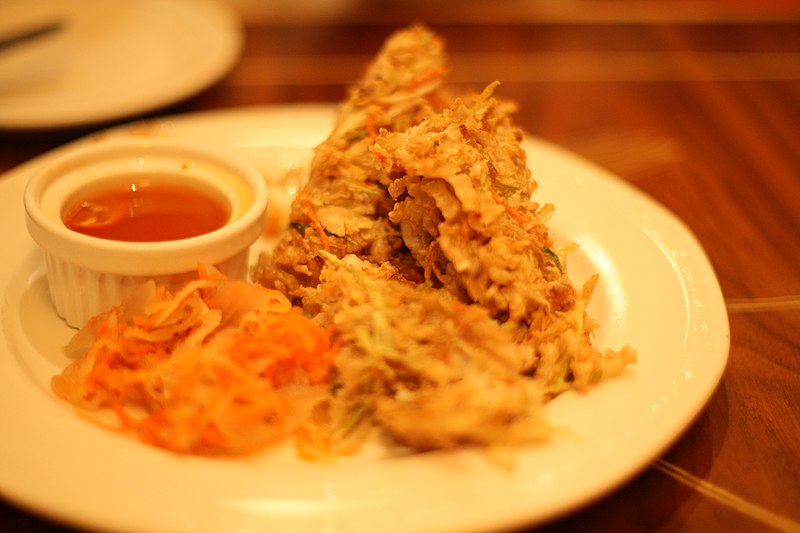
Ukoy, also known as shrimp fritter, consists of a batter (sometimes made from flour, squash, carrot, or other vegetables or fruits) with mung bean sprouts, carrots, and unshelled small shrimp – which when deep-fried yields a distinct crunch.
Cost: P10 to P15
14. Lumpiang togue
This popular veggie roll consists of mung bean sprouts or togie, papaya, carrots, onions, and seasoning.
Cost: P5 to P10
15. Calamares
The streetside version of the calamari dish served in casual restaurant, calamares comes in thin slices of squid, covered in crispy, golden-fried flour and egg batter. Great with vinegar!
Cost: P5 to P7 each slice
16. Chicken skin
Chicken skin is a must for people who love crispy skin on fried chicken. A cup gives you just that – thin, crackling bite sized chicken skin, which you can dip in a tangy vinegar dip.
Cost: Starts at P10
STEAMED/ BOILED
17. Taho
The quintessential “drinkable” Pinoy breakfast and snack, taho consists of silken tofu, a dark and sweet syrup called arnibal, and sago sweetener fresh soft/silken tofu, arnibal (sweetener and flavoring), and tiny sago (tapioca pearls).
Cost: Starts at P5 a cup
18. Siomai
An affordable Pinoy take on the famed Chinese dimsum, Pinoy siomai varies, from pork to chicken, to shrimp, though many also have lots of fillers. Served with calamansi, soy sauce, and even chili oil!
Cost: P10 to P15 per 3 or 4 pieces.
19. Nilagang mais
Though plenty of vendors sell nilagang mais (steamed corn on the cob) – or just mais – as is, some still offer them the good ol’ way: slathered with a generous amount of margarine, then drizzled with iodized salt. Yum.
Cost: P12 to P20 a cob
20. Sweet corn
A sweeter and cheesier take on corn, sweet corn is a cup of ear corns, removed from the cob, plus a spoonful or two each of sugar, powdered cheese, and margarine.
Cost: P10 to P20 a cup
FRUITS
21. Turon
An all-time favorite merienda, turon consists of slices of saba (cardava banana) with brown sugar – and sometimes langka (jackfruit), then rolled in lumpia wrapper and deep-fried in oil
Cost: P10 to P15
22. Banana cue
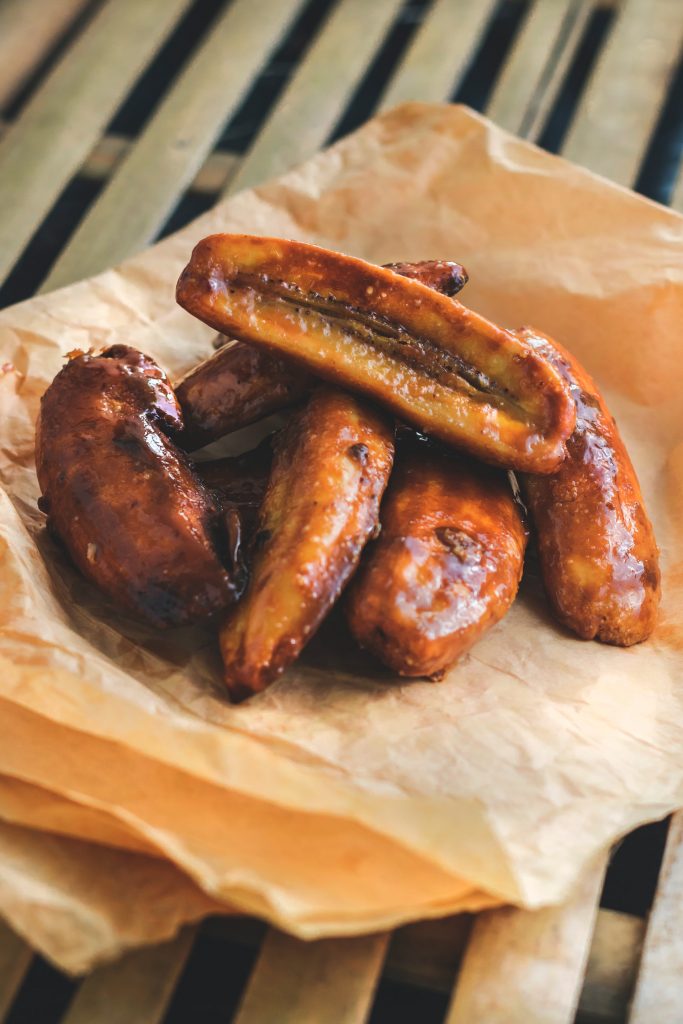
Saba is a hit in the Philippines, where it’s incorporated even in viands. It’s also a favorite item for desserts or snacks like banana cue, which consists of a couple of saba slathered with brown sugar, then deep-fried and skewered on a stick.
Cost: P10 to P15
23. Camote cue
Camote cue, or caramelized sweet potato, is cooked the same way as banana cue. You can find it either cupped in long, thin slices or in cut in circles, then skewered on a stick.
Cost: P10
24. Mangga’t bagoong
A ubiquitous fruit especially during the harvest months of March until June, variants of green mangoes – from the uber sour kalabaw to the small and sweeter Indian mango – are often sold in sidewalks peeled and in ready-to-eat slices. They also come with bagoong or sea salt.
Cost: P5 for a thin half slice to P20 for packs of 3 or 4 whole mangoes
SOUPS
25. Lugaw
Lugaw – rice porridge or congee – is a hearty comfort food for many Pinoys. A bowl of this simple porridge, infused with chicken broth and thin slices of chicken (plus hard-boiled egg as an optional add-on) can be ordered from mobile sidewalk carts for as low as P10.
If you like it a little meatier, opt for goto. It’s essentially the same base, but with bite-sized pieces of offal, such as liver, intestines, and gizzard.
Cost: P10 for lugaw; P20 for goto
26. Mami and beef pares
Another comfort food, mami is a street-style ramen/ noodle soup that is more basic than upscale ramen dishes. This one consists of dark beef broth, egg noodles, shreds or cubed beef brisket, and Chinese cabbage, then topped with spring onions and fried garlic bits.
Vendors selling mami also often sell beef pares, a rice bowl meal of fried rice with tender, cubed beef briskets in sweet and thick asado sauce. Best eaten piping hot!
Cost: P10 to P20 for mami; P20 to P30 for beef pares
SNACKS & DESSERTS
27. Sorbetes

Sorbetes – also called dirty ice cream – is the traditional Filipino ice cream. It is made with coconut milk or carabao’s milk instead of cow’s milk, making it a lot cheaper than the usual ice cream on the market. Sorbetes flavors also infuse homegrown fruits, such as mango, jackfruit, strawberry, avocado, and melon. Popular flavors also include ube (purple yam), cookies and cream, and cheese.
Sorbetes is served in cones, cups, or inside buns.
Cost: P5 for cups and cones; P10 to P15 for buns
25. Iskrambol
Iskrabol (or ice scramble) is a slushy drink made from shaved ice mixed with banana extract and condensed milk (some use evaporated milk and sugar in place of condensed milk). The ice is often dyed either in purple or pink. It is served in small cups and topped with condensed milk, chocolate syrup, powdered milk, marshmallow bits, and sometimes, choco bits or sprinkles.
Cost: P5 to P10 depending on cup size
REFRESHMENTS
29. Sago’t gulaman
A popular cold beverage sold by hawkers, sago’t gulaman (also called “palamig” or “samalamig”) is made with brown sugar and water, and comes with tapioca pearls (sago) and colored gelatin (gulaman).
Cost: P5 to P10, depending on cup size
30. Buko juice
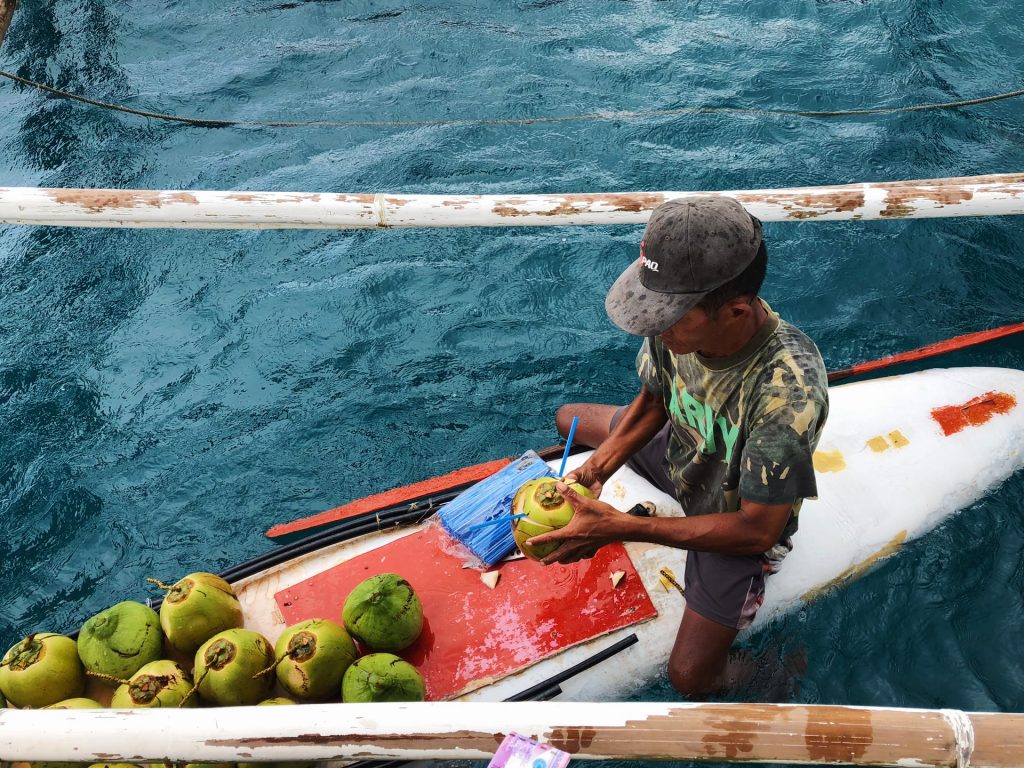
Buko juice is a simple, refreshing drink made with water, some sugar, coconut juice, and shreds of coconut. Buko juice vendors also sell fresh coconut that you can sip straight from the shell.
Cost: P5 to P10 for buko juice, depending on cup size; fresh coconut depends on the season




